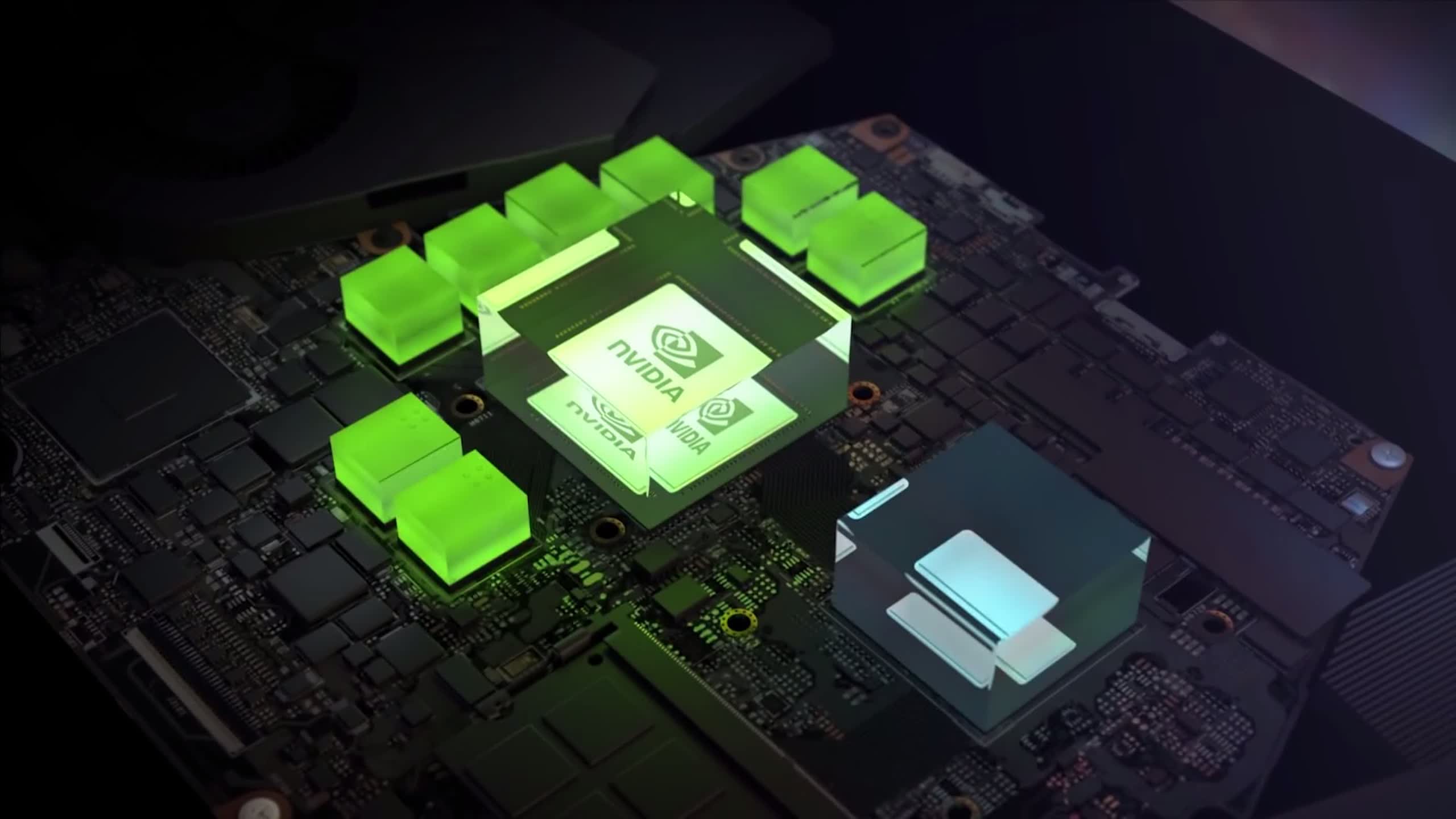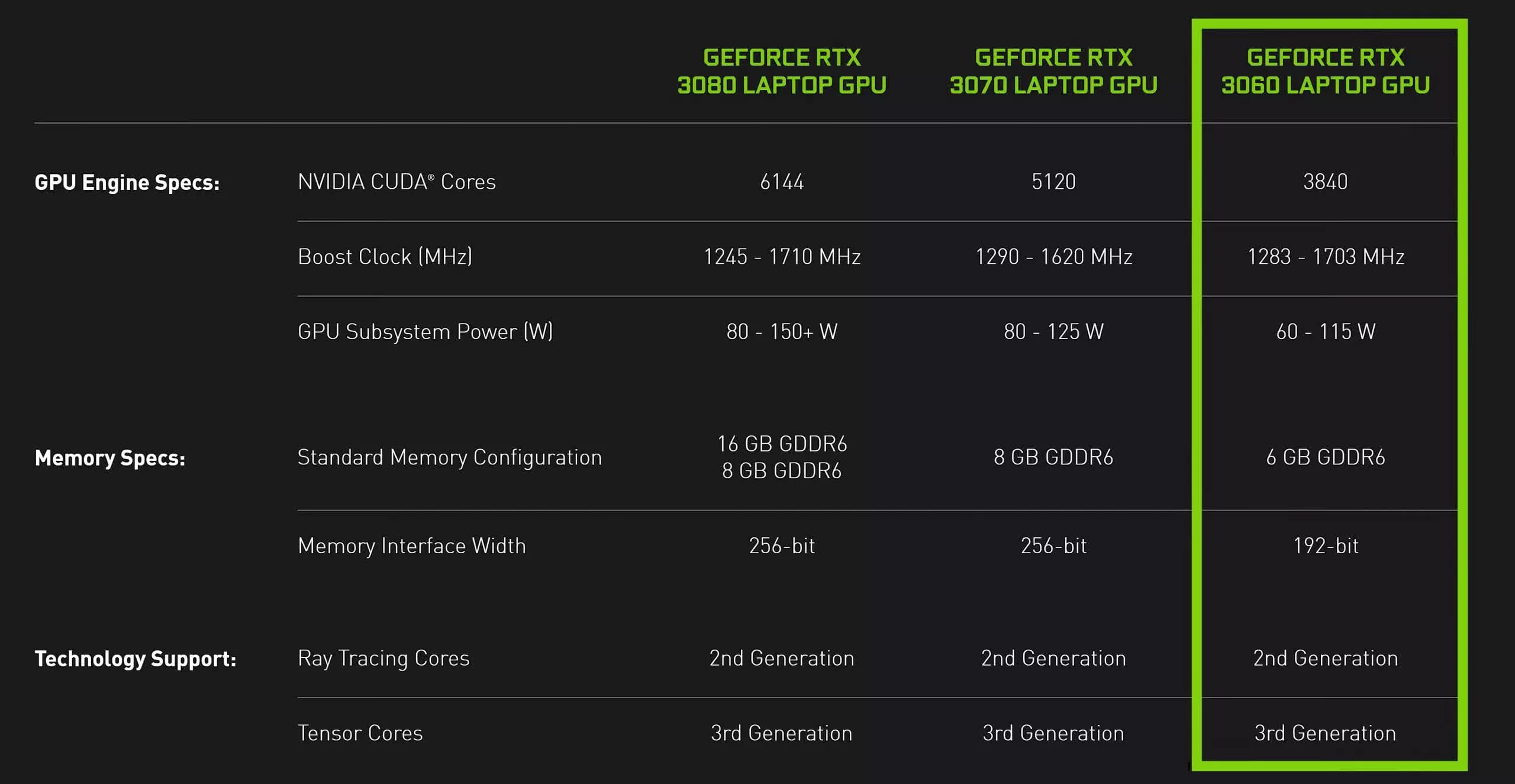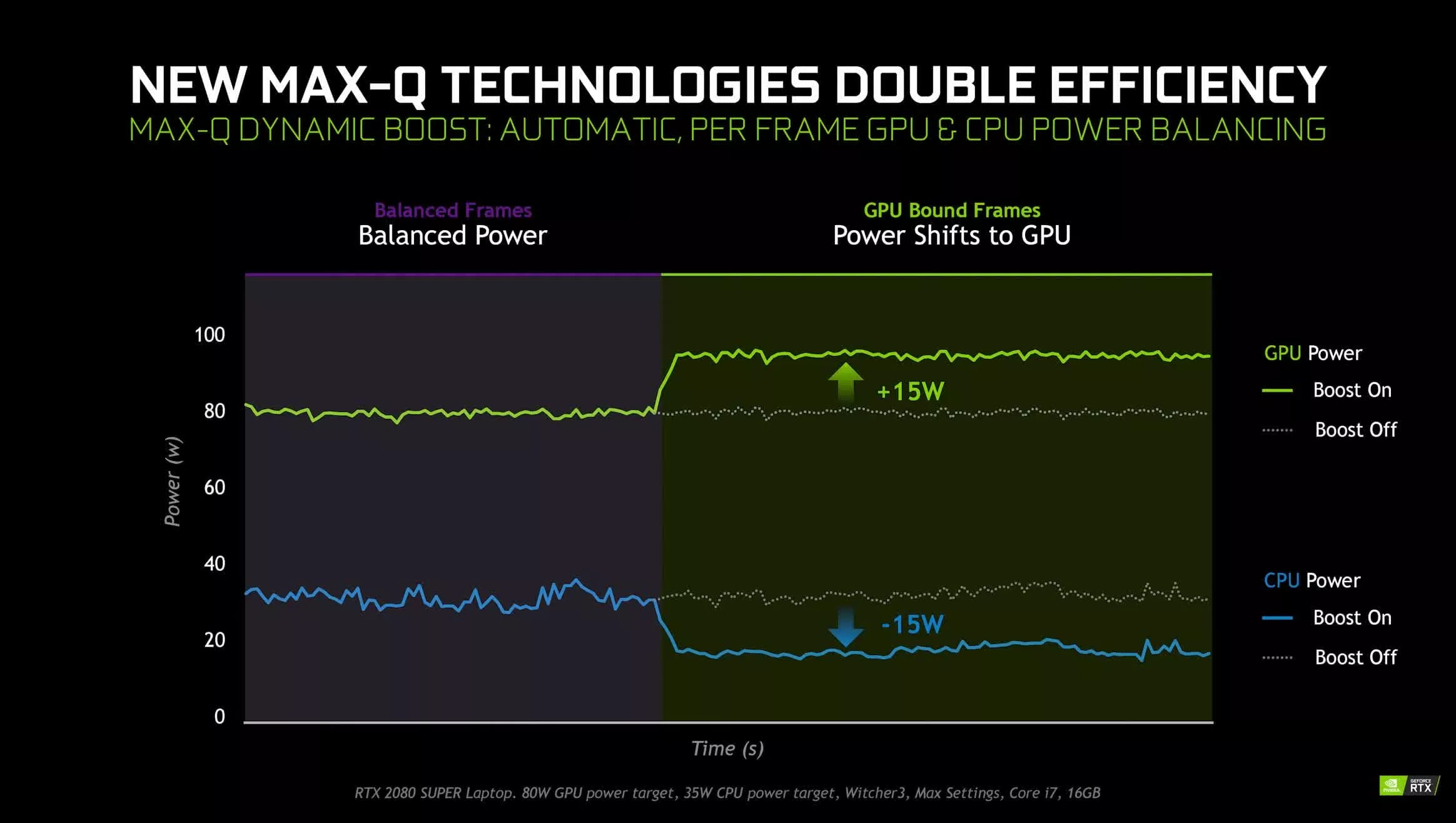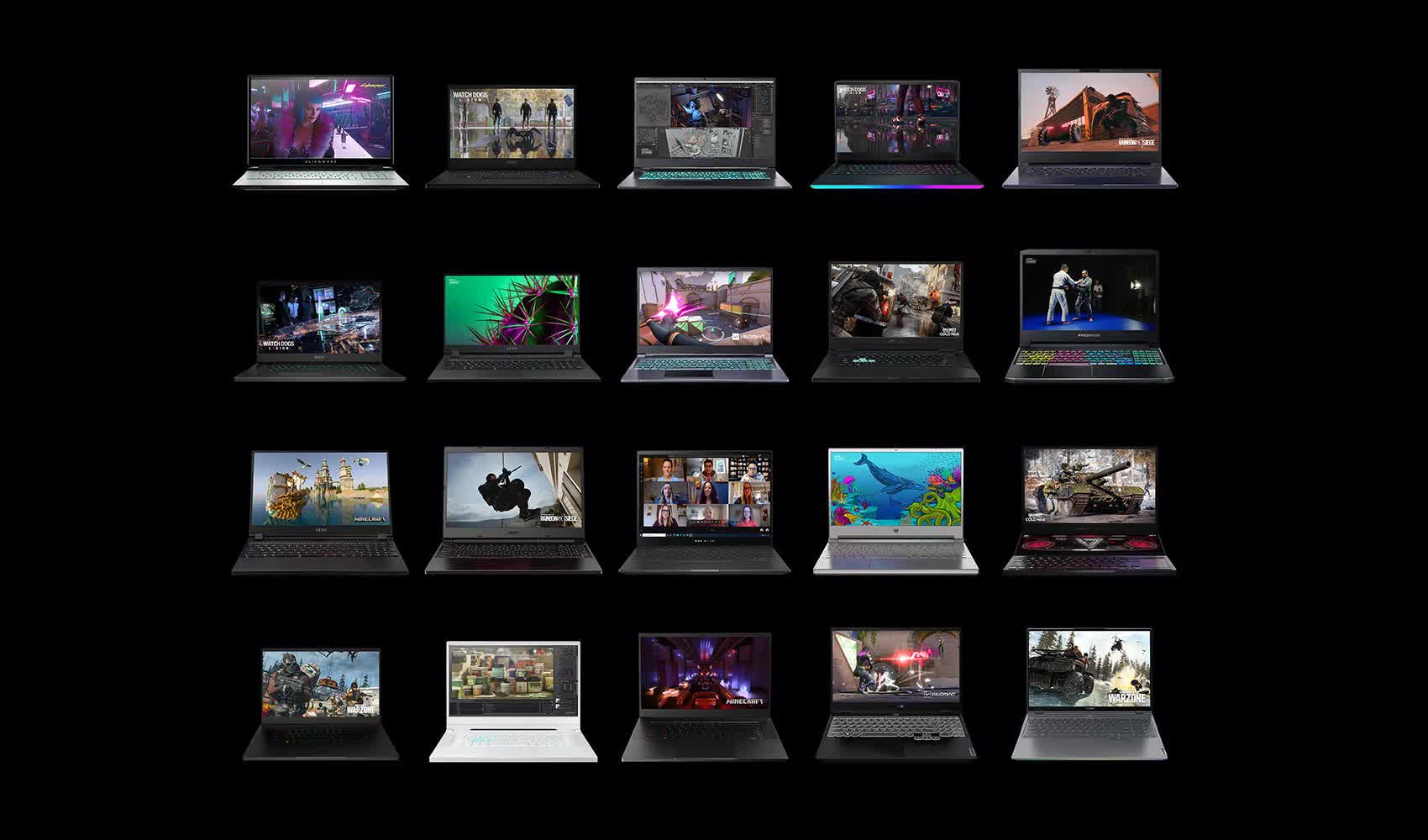We're kicking off our reviews of Nvidia's RTX 30 laptop GPUs with a look at the GeForce RTX 3060, the more affordable of three new Ampere mobile GPUs released so far. It's a little unusual to be reviewing a laptop GPU variant before the desktop chip, but to align with the laptop release cycle and the launch of AMD's new Ryzen 5000 APUs, we're getting the RTX 3060 alongside the RTX 3070 and RTX 3080 all at the same time.
The mobile RTX 3060 is using Nvidia's GA106 silicon with 3840 unlocked CUDA cores, more than what you'll find in the desktop equivalent. There are a range of power configurations that OEMs can use, anywhere from 60 to 115 watts, which brings with it a boost clock anywhere from 1283 MHz to 1703 MHz depending on the variant you get. Of course, one of the key talking points around this generation is Nvidia removing the "Max-Q" label, instead giving all configurations from the 60W model (previously Max-Q) up to 115W (Max-P) the same name, something we're not big fans of.
The memory configuration for all RTX 3060 laptop variants is 6GB of GDDR6 on a 192-bit bus, with clock speeds of either 14 Gbps or 12 Gbps depending on the power class. As this is a new GPU featuring the Ampere architecture, it's built on Samsung's 8nm process node and features all the new architectural benefits like 3rd-gen Tensor cores, 2nd-gen ray tracing cores, and dual FP32 pipelines.
For laptops specifically, Nvidia has introduced a range of new technologies such as Dynamic Boost 2.0, WhisperMode 2.0 and Resizable BAR, to go along with previous stuff like Advanced Optimus. While these features fall under Nvidia's Max-Q umbrella, they aren't restricted just to low power variants; all RTX 30 GPUs can use them. Not all of these features are required to be used though by the laptop manufacturer. From what we've seen so far, uptake Dynamic Boost in particular has been far higher than in prior generations.
For today's review, we'll be testing two variants of the RTX 3060 mobile GPU: one with a base power rating of 80W, and another with a base power of 115W. Note how we specify "base power" here as both come with Dynamic Boost 2.0, which is enabled by default. This balances system power load while gaming, and in some situations where CPU usage is light, it can enable the RTX 3060 to run up to 15W higher. Considering it's enabled out of the box on both systems, this is how we'll be testing these laptops and we'll be reporting a power range on our benchmark charts.
Our RTX 3060 115-130W system today is the XMG Apex 17, a powerful beast of a system with significant cooling capacity. The RTX 3060 inside has a base clock of 1387 MHz and boost clock of 1702 MHz, along with 14 Gbps memory. It supports Dynamic Boost and Resizable BAR, but not WhisperMode or Advanced Optimus.
The XMG Apex is powered by the Ryzen 7 5800H, a new Cezanne APU that just launched and we'll be reviewing in detail soon. There's also 16GB of dual-channel DDR4-3200 memory and a 17-inch 1080p 144Hz display. 1440p laptops are also starting to filter into the market now, but our testing for today will remain at 1080p. We'll look to add 1440p to the mix in the future.
Our second RTX 3060 laptop is another XMG Apex 17 but equipped with a 80-95W GPU power configuration. The laptop is a slightly different model with a thinner chassis and smaller cooler. Clock speeds are 900 MHz base and 1425 MHz boost, also with 14 Gbps memory. This laptop features Dynamic Boost and WhisperMode, but not Resizable BAR or Advanced Optimus. Perhaps the lack of Resizable BAR is down to the use of an Intel CPU. There's also 16GB of dual-channel DDR4-3200 memory and a 17-inch 1080p 144Hz display.
It's interesting to see that XMG and ODM Clevo have decided to make Ryzen 5000 processors the focus of the Apex 17 series. While many aspects to these chassis are similar, the AMD model is notably larger and has better cooling, allowing it to run the GPU at a higher power rating for better performance. This is opposite to previous generations where Intel was always given the higher end designs.
With that said, both of these Apex models are the sort of entry-level chassis options that XMG offers. Core and Neo models sitting above with slimmer builds and more premium materials.
Benchmarks
We're starting off with some older games where we have more comparison data, then move into newer benchmarks with a smaller range of systems. Shadow of the Tomb Raider is up first, and immediately we're seeing pretty decent results.

There wasn't a huge difference between the power configurations of our RTX 3060 laptops in this test, but it did allow the 80-95W model to deliver 17% more performance than a 90W power configuration of the RTX 2060. So a similar power configuration here, just a decent chunk more performance out of the new RTX 30 series GPU.
This places the RTX 3060 slightly above the RTX 2070 Super Max-Q in our charts. Meanwhile for those with a system a couple of generations old, say a GTX 1060 6GB for example, you're looking at more than 65% better performance in the same power class.

In Metro Exodus, the RTX 3060 is able to flex its muscles, especially with the 115W power configuration. In both instances, the new RTX 3060 is pretty similar to an RTX 2070 Super of the same power rating, putting it towards the top of the charts. At 80W we're seeing 16% more performance than the RTX 2060, although this extends to a 30% delta at 115W. Plus, if you're upgrading from an older system or something lower tier, the gains are much more substantial.

Control is extremely GPU limited on laptops, and as such shows some of the highest performance gains for the RTX 3060 over the 2060 at 1080p. We achieved a 27% higher frame rate when comparing at 80-95W, and 21% higher at the maximum 115W configuration.
So generation on generation, in the same sort of laptop design with the same cooler, an RTX 3060 will be giving you a decent step up in terms of frame rate. This puts the 3060 slightly above the last generation RTX 2070 Super, but at a lower price point.

Borderlands 3 shows a solid performance improvement for the RTX 3060, pushing frame rates 17% higher in 80-95W range, and 19% higher in the 115-130W range, over the RTX 2060. This makes the 3060 about 5% faster than the RTX 2070 Super Max-Q in a lower power configuration, or equal to that GPU in a higher power configuration. And while we're not setting new records in the 90W power class with this GPU, we're getting 88% of the performance of the RTX 2080 Super Max-Q in a price range that's about half as expensive.

Red Dead Redemption 2 shows some of the strongest results in favor of the RTX 3060, with the new GPU delivering performance above the RTX 2070 Super in a watt for watt battle.
The 3060 ends up 24% faster than the RTX 3060 in both power classes, and almost twice as fast as the GTX 1060 for people thinking of upgrading from a much older laptop. Really, now is the time to think about ditching your Pascal gaming system for something newer.

Tom Clancy's Rainbow Six Siege is a classic example of a competitive game running at medium settings. With new AMD CPUs in these systems, we're no longer suffering a huge performance penalty choosing an AMD-based laptop, so the end result is both RTX 3060 laptops deliver similar performance.
Large gains for the RTX 3060 in this title over previous generation GPUs, which is going to be especially good if you buy a system with a 240 Hz display.

In Assassin's Creed Valhalla, the RTX 3060 is able to outperform the RTX 2070 Super Max-Q by a couple of frames, delivering a 17 percent performance gain over the RTX 2060 in a similar power class. Especially at 115W, this makes Valhalla quite playable on very high settings at 1080p, which wasn't previously the case.

Cyberpunk 2077 requires a lot of GPU horsepower for decent frame rates at 1080p on a laptop, and ultimately we'd recommend people turn down the quality settings one notch with a mid-range GPU like the RTX 3060. 17% more performance on offer than the RTX 2060 here in the lower power class, however the RTX 3060 does fall behind the RTX 2070 Super in this game.

Watch Dogs Legion, even at 1080p on Ultra settings, is quite punishing on the RTX 3060 and part of that comes down to Ultra settings needing 8GB of VRAM. The 3060 has just 6GB, which in some areas of the benchmark causes stuttering and a somewhat lower 1% low than the RTX 2070 Super despite similar average frame rates.
We're still seeing a substantial 29% gain over the RTX 2060, another 6GB GPU, however we think having more VRAM for this game would be nice if you wanted to play on Ultra settings. With that said, how realistic ultra settings are for a laptop GPU is another question, and I'd probably turn down the preset one notch for actual gaming on a system like this.

Hitman 3 is the newest title in our benchmark suite, and for this test we are using the built-in test set to the Dartmoor level. This is an intensive test on both the CPU and GPU, with the RTX 3060 putting up a good showing relative to other products in the chart.
It is only 15% faster than the RTX 2060 in a watt for watt battle, but utterly obliterates the GTX 1060 configuration which is hamstrung by just a quad-core Intel 7th-gen processor.

The final benchmark we'll be showing in detail today is Dirt 5. The results seen here don't differ too much from the previous results, but this is a newer and more performance intensive title in some ways. With 17 percent more performance than the RTX 2060 on offer, it allows the 80-95W configuration to match the RTX 2070 Super Max-Q.
Performance Breakdown
Time for some head to head comparisons featuring 20 games in our up-to-date laptop GPU benchmark test suite. When comparing the RTX 3060 (80 to 95W) with Dynamic Boost enabled, to the average of all our RTX 2060 laptops running at 90W, the RTX 3060 ends up 19% faster on average in the same power class.

Some results were not as high for the new RTX 30 series GPU, like Gears 5 and Cyberpunk with ray tracing enabled, while other games like Control and Watch Dogs Legion could be nearly 30 percent ahead on Nvidia's new GPU.
In the higher power class – 115W-130W – we don't have as many games that can be used for a comparison. However, from the tests ran we can say that the RTX 3060 is 22% faster than the RTX 2060 on average. This suggests that the 3060 is delivering a similar improvement to efficiency over its Turing predecessor regardless of whether you get a mid-tier or higher-end power configuration.

Another useful comparison is that the RTX 3060 provides similar performance to the RTX 2070 Super when you're on a similar power class. The one outlier here is Cyberpunk 2077 with ray tracing enabled, where 6GB of VRAM is not enough and causes a significant performance loss compared to the 8GB-equipped 2070 Super. Remove that result and the 3060 is a couple percent faster on average.

Not unlike what we've observed from previous generations, the higher 115W power configuration is 11% faster on average than the 80W config of the RTX 3060. While there is also a CPU difference at play here, most of our gaming benchmarks are GPU limited, with results ranging from a low single-digit improvement, to an uplift of 20% or more, depending on the game. These two power classes deliver fundamentally different performance and, of course, the 115W model is faster.

For those looking to upgrade coming from a GTX 10 series Pascal GPU of the same class, the RTX 3060 provides a huge 72% performance gain over the GTX 1060 6GB on average.
For those looking to upgrade coming from a GTX 10 series Pascal GPU of the same class, the RTX 3060 provides a huge 72% performance gain over the GTX 1060 6GB on average. Factored into this is also the uplift moving from a dated Intel quad-core that was commonly used in 2017's laptops, to a new 8-core CPU that will be widespread across today's gaming systems. This is the primary comparison Nvidia is making for RTX 30 laptop GPUs and it makes sense given with these sorts of gains we think considering a gaming laptop upgrade is well worth it, especially for modern games.

The MaxQ naming issue (update)
Update (Feb 5): Shortly after publishing this review, Nvidia announced that they will now require all companies selling RTX laptops to be more transparent about their graphics subsystems. In other words, while Nvidia used to encourage manufacturers to state clocks and power consumption on their product pages, now it requires them to do so. The Max-Q branding can still be used, albeit for different reasons, such as indicating support for Dynamic Boost 2.0, Advanced Optimus, and Whisper Mode 2.0.
Many RTX 30-series laptop listings have yet to be updated to reflect differences in the clock speed and total power consumption. However, manufacturers like Asus, Acer, Razer, Origin, MSI, Alienware, and Gigabyte have already updated some product pages, so things are moving in the right direction for consumers.
Clearly, the new RTX 3060 laptop GPU delivers on the performance front, that's why it's disappointing Nvidia has decided to confuse users with mixed naming schemes - in particular the removal of Max-Q branding. We've been banging on about this for years now, but the problem is bad enough that even mainstream media is catching on. Laptop makers usually only indicate what's the basic GPU name (e.g. "RTX 3060"), but different power configurations all differ in performance as we just saw in this review, sometimes significantly so.
Essentially, the problem is that the same GPU model is being used across several power configurations.
Nvidia used to mitigate this somewhat by branding the lower power (and slower) variants as "Max-Q" and higher-power laptops with "Max-P." And while there were still more sub-variants between the two extremes, this could at least give you some hint before you bought a new laptop. That's no longer possible with 2021's laptops.
Using today's review as a basic example, we looked at two RTX 3060 laptop GPU configurations that used an 80W and 115W base power level. The performance difference was 10% on average. That's significant enough in our opinion, but we didn't test the even lower power 60W variant of the 3060 which could be 15-20% slower, which is basically an entirely different GPU class at that point.
Now, Nvidia has said that they are encouraging laptop makers to be clear about the power and clock speeds of the laptops they sell. But let's be honest. What maker wants to admit their cooling solution is inadequate and that they're using a slower GPU variant?
The solution is simple, these GPUs should be given different names. The RTX 3060 at 115W could be the RTX 3060MX, the 80W model could be RTX 3060M and the 60W model could be RTX 3060Q. There, solved.
What We Learned
Overall, there's a lot to like from the new RTX 3060 from a performance standpoint. The laptop GPU provides a notable performance uplift over previous parts of the same class and power level, which is something we couldn't say about Nvidia's Super refresh last year.
The upgrade to the Ampere architecture and Samsung 8nm process presents a solid leap for laptop hardware; hardware that's constrained by power and requires new architectures and next-gen process nodes to provide a leap in efficiency and therefore performance per watt.
When we compare two laptop GPUs in the same price segment, relative to its generation - RTX 3060 vs RTX 2060 - we get 20% better performance on average. So if we have two laptops with the same design, same cooling capacity, and likely a similar price tag, the newer RTX 30 series option is going to deliver a decent performance gain in today's games at 1080p. That's exactly what we're looking for.
The generation on generation performance leap with Ampere vs. Turing isn't as large as we got from the Pascal to Turing upgrade on laptops. The RTX 2060, for example, was about 28 percent faster in our 2019 testing compared to the GTX 1060. However, in this instance Nvidia also increased the price tag. That isn't the case with the RTX 3060.
Shopping for a gaming laptop
In today's market, our conclusion above is not factoring in two key data points. First, this price comparison is based off the MSRP. We can't say for sure if gaming laptops will see inflated pricing due to the current terrible market situation for GPU hardware. It also doesn't account for end-of-life discounts on RTX 2060 laptops, so initially there may be a bargain to be had on last-gen hardware. But if we are comparing launch pricing to launch pricing, the RTX 3060 is well positioned and buyers are getting better performance per dollar.
Another way to look at it is that the RTX 3060 matches the performance of the RTX 2070 Super from the previous generation, a GPU that was two steps above in the hierarchy. Those laptops used to cost around $1,800 or more, while some RTX 3060 laptops should be as low as $1,000-1,200. It's hard to make a direct comparison right now as most RTX 30 series laptops aren't available to buy just yet, but the early signs are a very strong value proposition for the RTX 3060 class of laptops.
It's also a promising landscape for those wanting to upgrade from a 4-year-old GTX laptop. Even when you don't factor in a drastic step up in CPU performance – from say the i7-7700HQ – new display tech and all the other benefits of modern laptops, the RTX 3060 alone is 70% faster than the GTX 1060 in the same power class. That's enough of a performance gain to justify an upgrade.
From a performance standpoint and even without taking into consideration value-added features like ray tracing, DLSS, Dynamic Boost and so on, Nvidia is delivering the goods right now in the laptop market.









